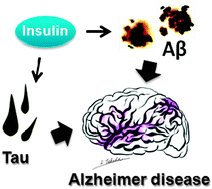The incidence of Alzheimer disease (AD) and diabetes mellitus (DM) is increasing at an alarming rate and has become a major public health concern worldwide. Recent epidemiological studies have provided direct evidence that DM is a strong risk factor for AD; this finding is now attracting attention. However, the underlying mechanisms for this association remain largely unknown. Previous in vitro and in vivo studies reported that diabetic conditions could cause an increase in the beta-amyloid peptide (Aβ) levels, which exhibits neurotoxic properties and plays a causative role in AD. However, unexpectedly, recent clinicopathological studies have shown no evidence that the pathological hallmarks of AD, including amyloid plaque, were increased in the brains of diabetic patients, suggesting that DM could affect the pathogenesis of AD through mechanisms other than modulation of Aβ metabolism. One possible mechanism is the alteration in brain insulin signaling. It has been shown that insulin signaling is involved in a variety of neuronal functions, and that it also plays a significant role in the pathophysiology of AD. Thus, the modification of neuronal insulin signaling by diabetic conditions may contribute to AD progression. Another possible mechanism is cerebrovascular alteration, a common pathological change observed in both diseases. Accumulating evidence has suggested the importance of Aβ-induced cerebrovascular dysfunction in AD, and indicated that pathological interactions between the receptor for advanced glycation end products (RAGE) and Aβ peptides may play a role in this dysfunction. Our study has provided a further understanding of the potential underlying mechanisms linking DM and AD by establishing novel mouse models showing pathological manifestations of both diseases. The current review summarizes the results from recent studies on the pathological relationship between DM and AD while focusing on brain insulin signaling and cerebrovascular alteration. It also discusses the therapeutic potential of these findings and future treatment strategies for AD.

You have access to this article
 Please wait while we load your content...
Something went wrong. Try again?
Please wait while we load your content...
Something went wrong. Try again?


 Please wait while we load your content...
Please wait while we load your content...